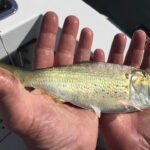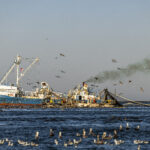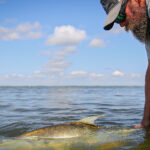
Menhaden Industry Risks Sustainability Certifications
Recent developments in the 2025 Atlantic Menhaden Stock Assessment Update, released by the Atlantic States
Last Wednesday, the Atlantic States Marine Fisheries Commission’s Striped Bass Board met to review a draft of Amendment 7 to the Striped Bass Fishery Management Plan, with the clear intent to finalize it for public review and comment. That’s not exactly what happened though.
More on this in a minute. First, here’s the short version of how we got here.
Back in 2019, the Commission accepted a stock assessment that told us what most folks who spend real time on the water already expected – the stock was overfished (the number of spawning females had dipped below what scientists considered a healthy stock), and overfishing was occurring (we were fishing at a level that would continue to deplete the stock).
To the Commission’s credit, it acted uncharacteristically quickly. Addendum VI was initiated, and a year later an 18% reduction in fishing mortality was mandated across the coast. Of course, that process was anything but perfect. While coastal states were required to take that reduction with a 28 to 35” slot limit (I would note here that we favored a 35” minimum size limit at the time), there were a few states that did their usual gaming of the system with “Conservation Equivalency” regulations. Without getting into too much detail, some states, New Jersey in particular, took a smaller reduction than they would have had they complied with the coastal slot limit standard. That lowered the possible success rate of Addendum VI significantly. That said, all indications thus far are that, from a coastal standpoint, Addendum VI has achieved its goal of reducing fishing mortality by at least 18% and returning it to, or even below, the fishing mortality target. From an anecdotal standpoint that does appear to be the case. A LOT of large fish are being put back, and the frequent lament on the radio is that keepers within the slot are hard to come by.
But let’s move on here. What Addendum VI didn’t do was initiate a rebuilding schedule. It is a clear requirement in Amendment 6 that when the stock becomes overfished, the board must implement management measures that would allow it to rebuild to the spawning stock biomass target within 10 years—in this case, by 2029 (more on that later). There was plenty of hemming and hawing by the Board and staff, but it was clear to everyone that the 18% reduction in fishing mortality simply wouldn’t achieve that.
During all of this, Maryland, in particular, but also New Jersey and Delaware, seemed to be angling for ways to relax regulations, during a time when it was clear the stock needed less fishing pressure, not more. Maryland actually initiated Amendment 7 with the argument that Chesapeake Bay (the largest striped bass spawning estuary, where 60 to 80% of the coastal stock originates) had become less productive, thus we should have lower biomass targets and subsequently allow fishermen to kill more fish.
But once the first round of Amendment 7 hearings were completed, it became VERY clear that this was NOT what the fishing public wanted. Unsurprisingly, the public wanted more aggressive conservation measures, quicker reactions to bad news, and for striped bass rebuilt to historical highs, not the opposite. And the Commission’s Striped Bass Board appeared to listen!
The end result was that there were lots of bad things removed from that first iteration of Amendment 7 at this year’s May Board meeting. One such example was axing the consideration of new reference points that could have significantly lowered the bar on what a healthy stock looks like.
Still, provisions remaining in the document could still weaken the current management plan—most notably, the triggers required for management action. And we should also be clear that, while one of the goals of Amendment 7 was to develop a rebuilding plan to bring striped bass to the spawning stock biomass target by 2029 (10 years after the Board accepted a stock assessment that made clear the stock was overfished), there was very little mention of that (other than a proposal to remove the 10-year requirement) in any iteration of draft Amendment 7.
So, here’s where we are now. After most of the bad stuff was removed this spring, what the Board chose to address were management triggers, measures to protect the 2015 year class, recreational release mortality and the Conservation Equivalency program.
Wednesday’s discussion started with the management triggers. Without getting into too much detail, some options to delay taking action stayed in the document. But, yes, some of the most egregious ones were taken out. Currently, if overfishing occurs action must be taken to implement management measures that would correct it within one year. An option that would require a rebuilding plan in three years, instead of the current one year, was deleted, but a two-year option stayed in, which is NOT terrible as that’s essentially the requirement for the regional fishery management councils subject to federal fisheries requirements. Fortunately, an option that would only require action only if the average fishing mortality over a five year period exceeded the fishing mortality target was also removed, as was one that would not require action unless fishing mortality exceeded the target AND the spawning stock biomass was below the target for two consecutive years.
One place where there appears to be almost certain improvement was the recruitment trigger—how the Commission will respond to periods of poor (or mediocre) spawning success. This gets a little bit complicated, but we can simplify it here and say that Commission staff has developed options that should identify clear patterns of poor recruitment and require managers to act on them. To put it more clearly, if the striped bass stock doesn’t appear to be having good spawns for a number of years, well, with the new trigger options, they would have to address it.
Regarding the protection of the 2015 year class, this gets really complicated too. Of course the 2015 year class was an unusually good one, and will likely be an important asset for rebuilding the spawning stock biomass. And… they are recruiting into exploitable size (in other words right into the slot limit) this year or next. Even if a larger minimum size limit was implemented with Amendment 7, it wouldn’t go into effect until 2023 and thus would fail to protect a lot of the steadily growing 2015s. Regardless, one would think that adjusting to a large minimum size limit would offer those fish some protection, but when it’s looked at over a long time period, it really doesn’t because those fish will/should eventually recruit into that exploitable range; regardless of the size limit chosen, anglers may just shift effort to the exploitable size limit. Thus, according to Commission scientists, overall effort has much more impact on the stock than would measures that protect a particular year class. So, really, none of the minimum size/slot limit options would be terribly effective in protecting the 2015s.
And then, there was the “moratorium” option in the document. One important note before discussing this one—the harvest moratorium would have applied only to the recreational sector, NOT the commercial one. Seems pretty unfair, right? But the justification is that the commercial folks, managed under a fixed quota system, did not cause the overfishing/overfished situation. The recreational sector did because it expanded over the years and effort pretty much went through the roof. While of course, we can’t argue that point, it’s our position that if there’s a problem affecting all sectors, then all sectors should share in the burden of correcting it, and yes, we are well aware that goes both ways.
Of course, we opposed the moratorium option, but not simply for that reason. It’s just wasn’t politically viable. Not only would the recreational folks lose their minds if the Commission went down this road, but it would likely effect A LOT of recreational charter businesses … And for what? Commission scientists aren’t able to explain how a moratorium might impact the stock, and whether or not it would even help rebuilding… Because no one can tell how much recreational fishing effort would simply shift to catch and release fishing if people could no longer kill striped bass. It’s not unreasonable to presume a lot of that harvest could merely be converted into release mortality if a moratorium was imposed.
Furthermore, anyone with a real understanding the history of striped bass management (dating back to the 70s and 80s) and the current striped bass situation understands that a moratorium of any sort isn’t really needed at the moment. Of course, we harbor no misconceptions that a moratorium might indeed be needed at some point in the future if the stock continues to decline. But right now, as depleted as the stock is, the spawning stock biomass is way, WAY larger it was in the early 1980s, when the stock essentially crashed and drastic action WAS needed. And even back then, the Commission managed to fully rebuild the bass population by 1995 without ever completely closing the fishery.
At any rate, while all the size and bag limits options look like they will remain in the document for the public to comment on, the moratorium stuff was removed. And good riddance. The lesson learned here for those folks advocating for extreme measures, based more on emotion than on science, is to be careful what you wish for, because the moratorium option previously in the document would have been no good for anyone.
And that brings us to measures that would address recreational release mortality. As discussed on this blog and elsewhere more than once, those fish that die after being released (currently estimated at 9%, which in my opinion isn’t off the mark), when you take into account all the recreational fishing effort, adds up to almost 50% of total striped bass mortality. While that’s surprising to some, it shouldn’t be when you understand the sheer amount the amount of people practicing catch-and-release either because of the regulations or simply because they choose to do so.
So yes, discard mortality is a significant piece of this puzzle. Is it a big piece though? We don’t think so. When you have a fishery that’s primarily sport, and primarily catch-and-release, of course discards are going to be high. But there appear to be no good solutions for addressing it, because no one can really tell or quantify what sort of effect any of the proposed solutions would have. Want to really address fishing mortality? Well, you address what you effectively can, and that’s harvest. Still, there were options in the document for time and area closures, to control that effort (closed to harvest and/or closed to even targeting). There are many problems that come with this sort of thing, and we’re not going to get into them all here, but the big one is enforcement. You can close seasons to harvest, but as mentioned, that harvest could convert to discards once the harvest-oriented folks moved over to catch and release. And the no-target options? Come on man. 100% unenforceable, for as long as there are bluefish, or anything else for that matter, in the water, an angler would always be targeting everything else except for striped bass (and just happen to keep catching bass by “accident”).
Some of the more egregious time and area closure proposal options were removed from the amendment for the above stated reasons, but also because the New England states with shorter seasons argued that they would be affected more acutely. Yet, a proposal that would require state-specific closures, at any time during the year when substantial fishing took place, remains in the document for the public to comment on. Also left in was an option for spawning season closures, which certainly makes good sense from our perspective.
The Board also discussed gear restriction options that could work to reduce discard mortality. It was all pretty much common-sense stuff—prohibit the use of gaffs, treble hooks, barbed hooks etc. Ahem, except for the prohibition on the use of wire line trolling to target striped bass (not sure how this one even made it into the document, but it’s ridiculous). After some discussion, everything was deleted except for the prohibition on the use of gaffs. While it’s hard, and maybe impossible to quantify the effects of such gear restrictions, we did feel like everything, but wire line trolling, should have been left in for the public to comment on, as it’s hard to believe that those options wouldn’t have helped save a few fish.
Lastly, options that were intended to prevent the frequent abuse of the Conservation Equivalency (CE) program were discussed. Just to be clear, CE is the practice of allowing states to craft their own regulations as long as they provided equivalent conservation benefit to the coastal requirement. And it’s VERY clear that some states use it to get around constraining coastal measures and provide an advantage to anglers in their state at the expense of the coastal stock, not to mention other states.
Unsurprisingly, during the meeting the states most notorious for taking full advantage of the CE program argued successfully to remove the option to prohibit the use of CE all together. That’s unfortunate, as the public spoke loud and clear during the last round of public hearings that they wanted this in the document. That said, there are a number of options that would prohibit or restrict the use of Conservation Equivalency at certain times, such as when the stock is overfished or overfishing is occurring. There are also options requiring a certain level of precision in a state’s fishery data for CE to be used. And there were options that would require a conservation buffer in order to account for inherent uncertainty in the data used to justify CE measures. Fortunately, all of that stuff remains in the document, and should such options become part of the final Amendment 7, we would see A LOT less of states trying to use CE to get their anglers more fish.
And that takes us to one of the most significant events of last Wednesday’s meeting. As mentioned, up until now the Board has blown off an Amendment 6 management trigger which requires the board to initiate a rebuilding plan for striped bass should the stock become overfished. While it’s certainly been discussed during the Amendment’s development, there’s was no formal initiation of such a plan in the in the document, or anywhere else for that matter.
And so, the state of Maine put up a proposal to “Move to task the Plan Development Team to develop a formal rebuilding plan for striped bass in Amendment 7 using methods described under ‘Management Response to Recruitment Trigger.” In the motion, the maker stipulated rebuilding within 10 years of acceptance of the latest stock assessment for management use, and notably required the Board to consider the current low recruitment scenario given recent poor spawning success.
Of course, we consider this a welcome addition; however, because it wasn’t included in the Draft Amendment 7 document, and Commission staff hadn’t had a chance to flesh out/provide a full range of options, the fact that this motion passed will delay Amendment 7 public hearings. We should also note that there was an unforeseen motion by a Commissioner from Maryland that seeks to protect some of the stripers from the 2015-, 2017-, and 2018-year classes within the Chesapeake Bay, through a maximum size limit option in the Bay. That will require some staff vetting also. But none of this really matters all that much, as the final amendment should still be approved in enough time that it will still be implemented by the start of 2023, which was the best-case scenario in any case.
Now, just to add another layer of complication here, we’re expecting a new stock assessment in the fall of next year. And that, of course, could change how the Board views the striped bass situation dramatically. But talking about that right now is WAY premature. We’ll just have to see how that all plays out.
The bottom line is this: We had been working to prepare you for another round of public hearings in the coming months. Well, that’s clearly going to be pushed back. That said, we WILL let you know when and how you can engage in this process. Because this is important stuff. Some of the options that will allow delay need to get squashed. And these constraining Conservation Equivalency options need to become part of the striped bass management plan, because if you’ve followed this at all, you know well CE has and is being used by some states in a way in which clearly it wasn’t intended, to the detriment of stiped bass. And lastly, the Board really needs to get going on a rebuilding plan so businesses like ours, which depend on striped bass abundance, can, well, stay in business.
That’s all for now. Stay tuned.

Recent developments in the 2025 Atlantic Menhaden Stock Assessment Update, released by the Atlantic States

What’s going on? The “most important fish in the sea” just exposed one of the

Mario CampoFisheries Ecologist, Southeastern Louisiana UniversityScience and Policy Associate, American Saltwater Guides Association This discussion

The Jack Project continues to gather momentum as tagging teams across the Gulf and South
We rely on our members and donations to keep fighting for a sustainable tomorrow in marine conservation.
GIVE THE GIFT OF FISHERIES CONSERVATION THIS HOLIDAY SEASON. SHOP ASGA GOODS THAT FUND FISHERIES RESEARCH & ADVOCACY CAMPAIGNS
JOIN ASGA IN CALLING FOR CRITICAL MANAGEMENT ACTION AFTER YEARS OF SPAWN FAILURES & POOR MANAGEMENT.
By using this website, you agree to our use of cookies. We use cookies to provide you with a great experience and to help our website run effectively. To learn more, please review our privacy policy.
5 Responses
Thank you for the clear summary of these amendments. I marvel at some of the short sightedness of various states and, of course, industries.
John, thank you for being an eloquent and intelligent spokesman for recreational
Fisherpersons and for
clearly communicating the issues. Your efforts are very much appreciated
Hi John, Thank you for your good work and excellent report. I would add that there may be a missing link with regard to commercial bi-catch and related activities. The south fork ocean beaches were recently littered, once again, with over slot sized SB. Without getting into too much detail at this time, I am confident that the commercial take, bi-catch, tag management and log book reporting is not properly understood or documented. The recreation multiplier is around 9% for mortality, is there a mortality / bi-catch multiplier or guidance for the commercial take/harvest?
Thank you.
Thanks for the excellent summary for a landlocked civilian who only gets to fish for SB a couple of weeks a year. Keep up the good work.